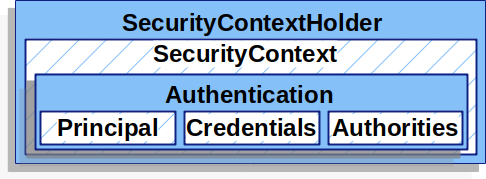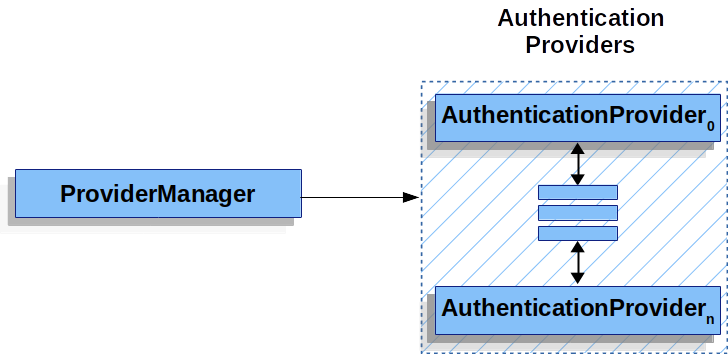Spring Security Authentication Architecture
Spring Security은 인증 기능을 지원해준다. 인증방식에는 Username/Password를 이용한 방식, OAuth2.0을 이용한 방식 등 여러가지 메커니즘들이 존재하는데 Spring Security는 여러가지 인증방식에 대해 모두 지원해준다.
Spring Security가 이러한 인증방식을 어떤 방식으로 처리하는지 동작방식을 자세하게 살펴보자.
💡 인증(Authentication)이란?
회원가입/로그인 과정이라고 생각하면 쉽다. 서비스에 접근하는 유저가 정당한 사용자인지 확인하는 과정이다. 인증을 통해 접근 권한(Authorization)을 부여할 수 있다.
Authentication Architecture
Spring Security은 많은 인증방식들(OAuth2.0, Username/Password)을 쉽게 사용할 수 있도록 도와준다. 우리는 내부동작을 몰라도 formLongin(), oauth2Login() 등을 통해 여러가지 인증 방식을 쉽게 구현할 수 있다.
각 인증방식들은 동작하는 방식이 조금씩 다르지만 동일한 아키텍쳐를 기반으로 동작한다.
SecurityContextHolder
SecurityContextHolder는 유저들의 인증정보들을 가지고 있는 인증정보 바구니이다. 현재 요청에 대한 유저의 인증정보을 가지고 있는 SecurityContext를 담는 그릇이다.
만약 현재 유저의 인증정보를 얻으려면 이 객체에 접근하면 된다. SecurityContextHolder은 ThreadLocal을 이용하기 때문에 현재 쓰레드에서는 항상 동일한 SecurityContext를 가져올 수 있다.
SecurityContext
SecurityContextHolder 내부에 존재하며 Authentication 객체를 가지고 있다.
Authentication
실질적으로 유저정보를 받아올 수 있는 인터페이스이다. 이 객체는 Spring Security에서 두 가지 목적으로 사용된다.
AuthenticationManager의 input으로 사용 - 사용자가 제공한 인증정보를 바탕으로 자격증명을 하기 위함- 인증된 유저임을 나타내기 위함
Authentication를 구현한 객체는 다음의 것들을 가지고 있다.
- principal - 유저식별자(Username/Password 인증방식의 경우
UserDetails객체) - credentials - 비밀번호(보통 보안을 위해 유저가 인증되면 사라진다)
- authorities - 해당 유저에게 보여된 role 이나 scope
AuthenticationManager
인증을 수행하는 방법을 정의한 인터페이스이다. authenticate() 메서드가 정의되어있다. 해당 메서드는 파라미티로 받은 Authentication 객체를 이용해서 인증을 수행하고 인증 처리된 Authentication 객체를 반환한다.
다음은 실제로 정의되어 있는 AuthenticationManager 인터페이스이다.
public interface AuthenticationManager {
/**
* @param authentication the authentication request object
* @return a fully authenticated object including credentials
* @throws AuthenticationException if authentication fails
*/
Authentication authenticate(Authentication authentication) throws AuthenticationException;
}
ProviderManager
AuthenticationManager을 구현한 객체로 Spring Security에서 사용되는 기본 구현체이다. 이 객체는 AuthenticationProvider(AuthenticationManager 아님 주의) 리스트를 가지고 있다. 각각의 AuthenticationProvider는 support 메서드를 지원하는데 이를 통해 인증처리를 진행할 수 있는지를 확인한다. 리스트 중 처리가능한 AuthenticationProvider가 존재하면 해당 AuthenticationProvider를 통해 인증을 처리하게 된다. 만약 처리가능한 것이 없거나 실패한 경우 예외를 발생시킨다.
ProviderManager가 AuthenticationProvider를 선택하는 방식은 주로 인증방식에 따라 갈리게 된다. 즉, OAuth2.0이냐 Username/Password이냐에 따라 다른 AuthenticationProvider을 실행하게되는 것이다.
이를 통해 여러 유형의 인증을 지원하고 단일 AuthenticationProvider bean만을 노출하여 특정한 유형의 인증을 수행할 수 있다.
ProviderManager는 다음과 같이 구현되어 있다. 아래적힌 코드뿐만 아니라 여러 기능을 하지만 그중 위에서 설명한 부분만 가져왔다.
AuthenticationProvider 리스트를 초기화하고 클라이언트의 요청이 들어오면 authenticate 메서드가 실행되어 적절한 AuthenticationProvider를 찾아 실행한다.
public class ProviderManager implements AuthenticationManager, MessageSourceAware, InitializingBean {
private List<AuthenticationProvider> providers = Collections.emptyList();
public ProviderManager(AuthenticationProvider... providers) {
// ... providers 초기화
}
@Override
public Authentication authenticate(Authentication authentication) throws AuthenticationException {
Class<? extends Authentication> toTest = authentication.getClass();
Authentication result = null;
/*
모든 AuthenticationProvider 순회
- support 여부 확인
- 지원가능하다면 처리 후 Authentication 받음
- 처리가능한 provider가 있을때까지 반복
*/
for (AuthenticationProvider provider : getProviders()) {
if (!provider.supports(toTest)) {
continue;
}
try {
result = provider.authenticate(authentication);
if (result != null) {
copyDetails(authentication, result);
break;
}
}
catch ( /*...*/ ) {
// ...
}
}
// ...
}
}
AuthenticationProvider
ProviderManager에서 설명했듯 인증종류별 처리방식을 제공한다. 예를 들어, DaoAuthenticationProvider는 Username/Password 인증방식을 처리한다.
AuthenticationEntryPoint
클라이언트가 능동적으로 Username/Password와 같이 인증정볼를 보내줄때는 상관이 없지만 인증되지 않은 유저가 권한이 없는 리소스에 접근을 한다면 자격 증명을 요청하는 응답을 주어야 한다. 이때 AuthenticationEntryPoint 인터페이스를 구현한 객체를 사용한다. 이 객체는 로그인 페이지로 리디렉션을 수행하거나 WWW-Authenticate 헤더등을 응답하여 인증을 요구한다.
즉, AuthenticationEntryPoint는 인증되지 않은 클라이언트의 요청에 인증을 유도하는 역할을 한다. 인증되지 않은 채로 리소스에 접근 시 적절한 응답을 전달하여 인증을 유도한다.
일반적으로 인증이 필요한 리소스에 접근할 때 호출되는 AuthenticationFilter에서 사용되어 인증여부를 확인하고 인증되지 않은 경우 AuthenticationEntryPoint를 호출한다.
AbstractAuthenticationProcessingFilter
인증 프로세스를 진행하는 모든 Security Filter의 부모 클래스이다. 사용자명과 패스워드를 사용한 폼 로그인을 처리하는 필터인 UsernamePasswordAuthenticationFilter, HTTP Basic 인증을 처리하는 BasicAuthenticationFilter의 부모가 AbstractAuthenticationProcessingFilter 이다.
요약
요약하자면 인증관련 Filter들은 다음과 같이 구현되어 있다.
Authentication Architecture
참고


댓글남기기